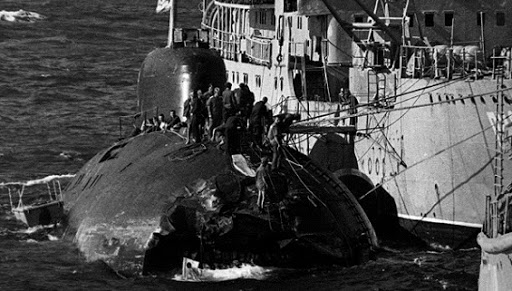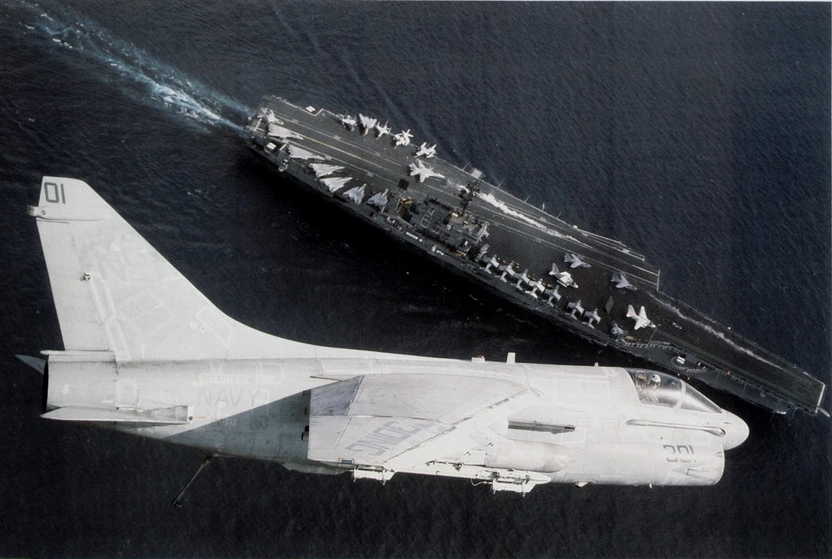‘I can see a scenario where a Soviet captain, during the height of the Cold War, would want to surface his sub in the middle of an American carrier task force as a ploy to try to prove the superiority of Soviet technology and Soviet seamanship,’ David Hornbuckle, former Nuclear Power Plant Mechanical Operator MM1/SS at US Navy.
In March 1984 USS Kitty Hawk (CV-63) Carrier Strike Group (CSG), with more than 80 aircraft and eight escort ships, entered the Sea of Japan to take part in a joint US-Korean exercise codenamed Team Spirit-84.
Such a powerful CSG not far from the Soviet Far East could not go unnoticed by the Soviet Pacific Fleet, in fact, the Victor-Class nuclear submarine K-314 was ordered to follow the aircraft carrier.
On Mar. 14, Kitty Hawk was located by K-314. The Soviet submarine began the chase of the US Navy aircraft carrier which soon discovered that it was followed by K-314 and did what it could to break away from the Soviet submarine.
As already explained in a previous article, this cat-and-mouse game continued for a week, until something unexpected happened.
On Mar. 20, K-314 rose to a depth of just 10 meters after having lost track of USS Kitty Hawk due to bad weather.
Through the periscope, Captain Vladimir Evseenko discovered that the entire USS Kitty Hawk CSG was only 4 to 5 kilometers away. More alarmingly still, the Americans and K-314 were heading toward each other at full throttle.
Evseenko gave an immediate order to submerge, but it was too late. K-314 and USS Kitty Hawk collided.
‘The Soviet submarine K-314 surfaced at 22:05 (10:05 PM) in front of the USS Kitty Hawk CV-63. The K-314, surfaced in front of the bow of the carrier at night and too close for either vessel to avoid the collision,’ David Hornbuckle, former Nuclear Power Plant Mechanical Operator MM1/SS at US Navy, on Quora.
‘It is a normal practice for submarines, when surfacing, to verify the area is clear of other vessels. Most submarines do a sonar sweep using passive sonar, plus the K-314 was shadowing the carrier task force in an attempt to gather intelligence, so I am fairly certain the K-314 did not do an active sonar sweep.

‘When surfacing, the periscope is raised (I am telling this from an American perspective since I served on two US submarines) and as soon as the scope breaks the surface, the OOD or Captain does a visual sweep for other vessels in the area.
‘Small boats and large vessels which are sitting still (some ships have to wait outside a port for high tide or a harbor pilot to enter port) make very little noise and can be missed on passive sonar.’
Hornbuckle continues.
‘How the sonar crew on the K-314 missed the sound of an 82,000-ton aircraft carrier bearing down on them is beyond comprehension barring a failure in their sonar system.
‘It is the submarines’ fault for surfacing directly in front of an underway aircraft carrier.
‘As for how it happened, I have an idea of how it might have gone. Soviet submarine commanders are known to be reckless when compared to American captains.
‘I can see a scenario where a Soviet captain, during the height of the Cold War, would want to surface his sub in the middle of an American carrier task force as a ploy to try to prove the superiority of Soviet technology and Soviet seamanship.
‘Using his sonar to position his sub in the Sea of Japan, which has a reputation for poor sonar operation at times, the Soviet captain thought he had positioned his boat perfectly.
‘Unknown to the Soviet captain, the aircraft carrier had gone to flight ops changing direction to head into the wind and increasing the speed of the carrier.’
Hornbuckle concludes:

‘It could have been bad timing that just as the Soviet captain surfaced his sub, the carrier had gone to flight ops and instead of being off his port or starboard side, the carrier was heading straight at him at 30 knots. No time to react or avoid the collision.
‘Instead of a propaganda success, it becomes a humiliation of the captain. Why the Soviet sonar failed to detect the USS Kitty Hawk is still the question about the incident that I would love to know the answer to. Whether this is what occurred that night, I don’t know. Just some thoughts from a former submariner.’
After the accident, Kitty Hawk immediately launched ‘two helicopters to see if we could render any assistance to them but the Soviet sub appeared to have suffered no extensive damage,’ Captain David N. Rogers, the ship commander, recalled.
K-314’s propeller was heavily damaged as a result of the collision. Kitty Hawk instead had a huge hole in its bow, causing several thousand tons of jet fuel to leak into the sea; by sheer miracle, it did not explode.
Luckily, nor did the nuclear weapons on board the Soviet and American vessels detonate.
Close escorted by a US Navy frigate for part of the route, the Soviet Submarine was towed to the nearest Soviet naval base.
For USS Kitty Hawk, exercise Team Spirit was over: the aircraft carrier in fact made its way to the port of Subic Bay for repair.
The Americans blamed the Soviet submarine captain for the incident, and the Soviet Naval command concurred. Vladimir Evseenko was suspended from the post of captain and continued his service on land.
Evseenko could not agree with such a verdict, since the incident had caused no loss of life or the submarine itself: “Everybody was lucky. We didn’t sink, no one got burned.”
“We even managed to kick out the ‘enemy’ for a long time,” he pointed out.
Photo by U.S. Navy

